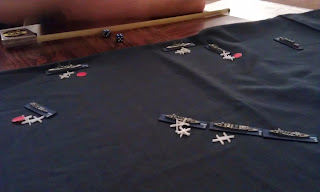I've been wanting to try QMG for some time, and I was very excited when Jerry said he'd bring his copy down to the club. I have always had a fascinating with grand strategic games of WW2, I played Third Reich a great deal, and even have two versions of Hitlers War (the AHGC version and the original Metagaming one).
QMG is an abstact grand strategic game for 2-6 players with units representing armies and navies (like Diplomacy), area movement (Risk/Diplomacy) and a deterministic combat system (ie no dice). The logistic elements and fog of war are generated by the card decks used to drive each countries actions (and they can also add a hidden element to combat).
I got to play plucky Britain. Here the Royal Navy holds the North Sea, whilst the wicked Jerries and Italians have overrun Europe. The Russians still hold Moscow and the Ukraine, but DAK control North Africa. American fleets patrol the western Atlantic
A more general view of the map, you can see the Japanese rampaging all over the Pacific on the left. Also visible are some of the player cards and force pools. The 'status' cards are permanent modifications to a countries capabilities, and some of them are really very good.
Things are hotting up in Europe. The DAK has been destroyed but Axis fleets still dominate the Mediterranean and Baltic.
In the Far East US Fleets build up, whilst the Japanese hang onto the Greater Co-Prosperity Sphere.
This really was excellent, and although we only got around halfway through as we were still learning the game, it gave a good flavour if it. I was particualrly impressed with the way the card decks had been constructed so that each country felt and played quite differently. I can't even begin to think of how I'd design a game like that, and I'm looking forward to playing it again.




































